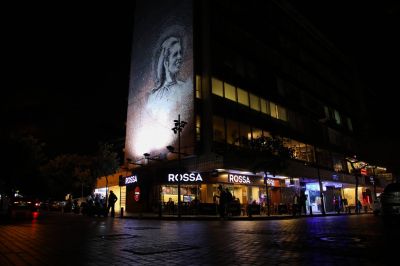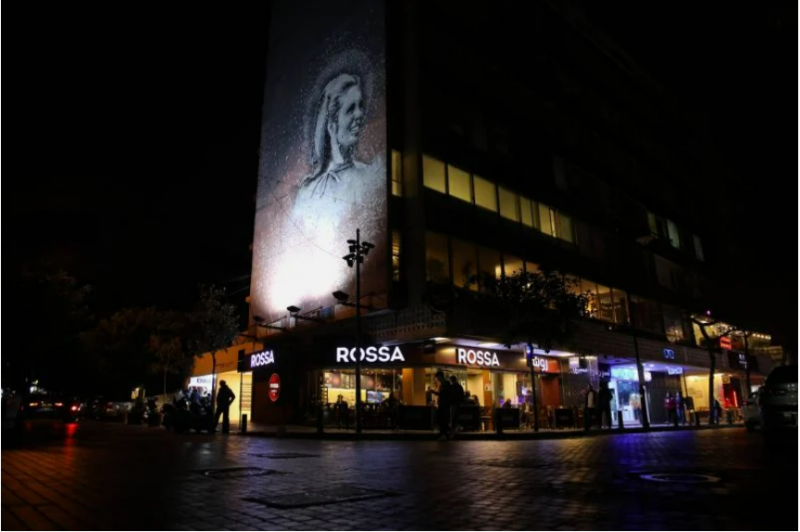
In the place of the first sidewalk café on Hamra Street, The Horseshoe, another has settled, Rossa, overlooked by a mural of the late Lebanese diva Sabah. (Credit: Florient ZWEIN/Hans Lucas)
More than two and half years have passed since the beginning of the crisis, but on Beirut’s one-time Champs-Elysées, the future seems to be stuck in the past.
“It’s over,” she kept repeating incredulously. She is the wife of the owner of a decades-old bookstore. She did not want to be named. “It is certainly more than 40 years old for sure,” she said, trying to remember.
Newspapers were laid out at the entrance. At the bottom of the stairs leading inside the bookshop, the emptiness was leaden.
The woman’s husband has been ill for the past nine month. He entrusted her with running the business.
“Enough time to leave without looking back,” she said.
“Everything has changed,” she added, gesturing outside with a wave of her hand.
The telephone rang. “No, we don’t have it,” she said apologetically. She put down the receiver. There was silence.
“It’s over,” she said once again.
At the end of February, Way In, the iconic Hamra Street bookstore closed its doors.
A few steps away, on this street that was once the busiest in Beirut, Fadi Nassar, an engineer, waited for clients who never came, except for a very few.
Established by his father in 1953, a small lingerie shop called Glamor has never closed. “Even during the war,” Nassar said. Since then, “the street has lost its charm.” It’s a euphemism everyone understands.
After his parents’ death, Nassar took over the reins. “Before the war, everything was fine. During the conflict, it was not so good. When the war was over, it was better,” he said.
“But this crisis…,” his words trailed off. The man in his 60s is not loquacious, but he is sure of one thing: No matter what lies in store for Lebanon, he will not leave.
“It’s human nature to hope,” Nassar said. “It will come back.”
Inside his Dallas clothing store, which was built “on a field of eggplants,” some 70 years ago, Zouhair Itani said, “This crisis is worse than the war.”
Since the onset of the economic crisis, “some 40 businesses have closed down.” Itani is also the president of the Hamra Traders Association, representing more than a hundred merchants.
The man is old, with vivid and lasting memories of the district that go a long way back.
“During the war, money circulated. When the guns fell silent, few businesses had permanently closed,” Itani said. “When the fighting was on hold, Hamra was alive.”
A little more than two and half years have passed since the economic collapse began, but in Hamra the future now seems to be stuck in the past.
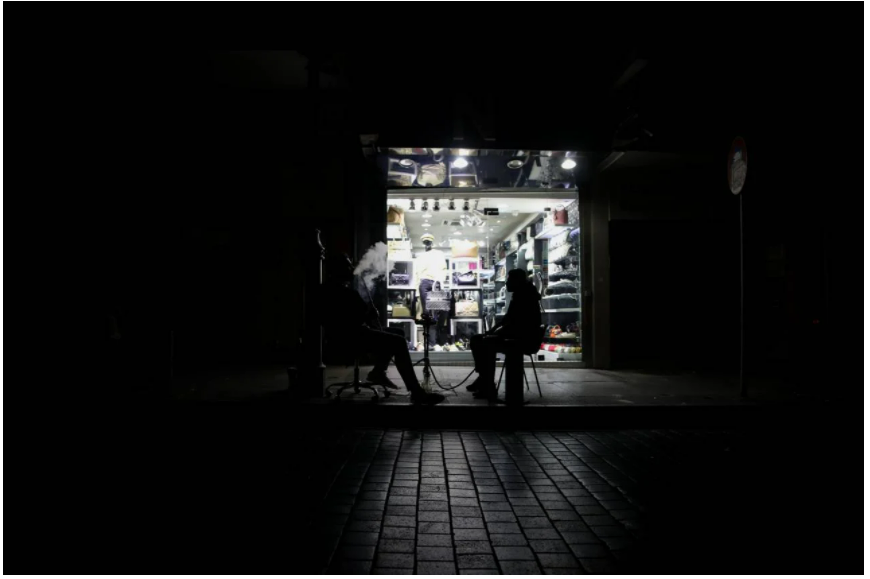 In the evening on Hamra Street some people smoke argileh on the sidewalk in the light of the neon lights of the shops. (Credit: Florient ZWEIN/Hans Lucas)
In the evening on Hamra Street some people smoke argileh on the sidewalk in the light of the neon lights of the shops. (Credit: Florient ZWEIN/Hans Lucas)
The 'Paris of the Middle East'
During a performance at the Piccadilly Theater, it’s said, Fairouz was sitting in the house. When she saw her from the stage, Dalida forgot her lines, then laughed and greeted her fellow diva. It was 1973. For decades, Lebanon had been living its “golden age” and Hamra was dubbed Beirut’s Champs-Elysées.
“We lived with doors open and walked shoulder to shoulder,” Itani recalled.
Rewind to 1969. Nidal Achkar, Lebanese actress and theater director, hailed as “the Grande Dame of Lebanese Theater,” was performing in her play “Majdaloun,” in front of the tables in The Horseshoe, Beirut’s first sidewalk café, operated in defiance of the authorities’ ban.
It was “one of the strongest moments of intellectual [history] of Beirut,” as Samir Kassir put it in his “The History of Beirut.”
“It was the most exciting street in Beirut,” Achkar recalled. “Everyone went there. People of all walks of life.” Homemakers, gamblers, politicians, businessmen, artists, journalists, prostitutes.
People lined up in front of the dozen movie theaters that mushroomed over a decade on the main street, including the cinemas of Al-Hamra, Eldorado, Strand, Colisée.
Personalities from the Arab world and beyond came to have a good time. The district was also home to international firms’ regional offices.
In 1964, the Banque du Liban, was established at the entrance of Hamra, where tourists exchanged their banknotes at the exchange offices dotting the street. Celebrities and personalities checked into the district’s hotels. Life was in full swing in the so-called Paris of the Middle East.
“The center of gravity of Beirut’s snobs,” this is how Gérard de Villiers described Hamra in the first volume of his series of SAS thrillers. It was the perfect location for inspiration, ,he wrote, where spies and “Europeanized fashion victims” met.
His first book was first published in 1972. It was titled Death in Beirut. Was it a bad omen? Behind the neighborhood’s glitter and glamor, chaos was lurking.
Thirty years after the war, “it is over,” as many of the district’s inhabitants told L’Orient-Le Jour.
“Hamra is the mirror of the crisis,” said Guillaume Boudisseau, a geographer and author of an academic study of the neighborhood, at the center of which Hamra Street has been a reflection of Lebanon’s history.
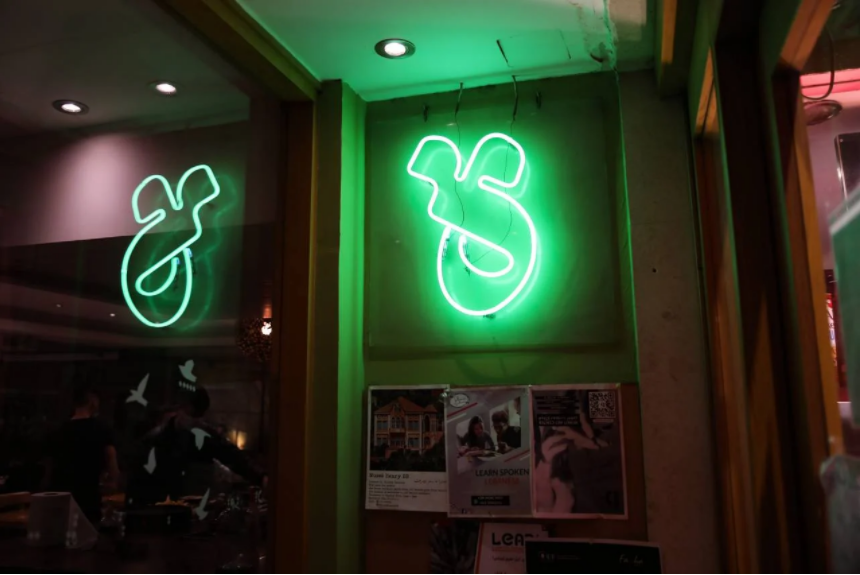 Opened in 2006 at its current location on Hamra Street, T-Marbouta stands out as "a semi-public space serving the local community", explains Abdel Rahman Zahzah, partner of this café-restaurant, located in the Hamra Square shopping complex. (Credit: Florient ZWEIN/Hans Lucas)
Opened in 2006 at its current location on Hamra Street, T-Marbouta stands out as "a semi-public space serving the local community", explains Abdel Rahman Zahzah, partner of this café-restaurant, located in the Hamra Square shopping complex. (Credit: Florient ZWEIN/Hans Lucas)
An organic street
Surrounded by his newspapers, Hassan, a newsstand owner who was reluctant to give his family name, turned down the volume on his radio. The pile of old CDs at his side was enough to keep him busy all day long.
Like war memorials, the stalls on Hamra Street remind the Lebanese of the street vendors who were scattered on the sidewalks, selling their goods off of their car hoods.
“There wasn’t any more place in the buildings,” Boudisseau explained.
“Of the nine kiosks that the municipality later installed, there are maybe three left,” Hassan said. Was he still able to sell his goods? The question was almost rhetorical.
“What people want today is enough money to eat,” he said, ending the conversation.
Around the corner from a perfume shop, one can see a mural depicting a man and his son, sitting on the sidewalk, begging. The painting is the work of American artist Brady the Black, from the Hamra-based Art of Change art community.
Camera in hand, a young man kneeled down to capture the painting when a child came up to him with hands outstretched, begging.
Like a sad mise en abyme, unfathomable for her young age, the intrigued child leaned over and looked through the lens. “We are all beggars,” the picture read.
“It’s an organic street,” said Abdel Rahman Zahzah, a partner in Hamra’s T-Marbouta café-restaurant, which occupied its current space in 2006.
“The problems of the street reflect those of the country.”
As early as 2011, with the outbreak of the Syrian war, the influx of refugees to this area changed the face of the neighborhood.
Slowly but surely, the demographics have changed, according to the street’s shopkeepers and customers.
Since the current crisis, however, Lebanese have joined Syrian refugees in street begging. “Poor and middle-class people,” Zahzah said, people who are left with no other choice.”
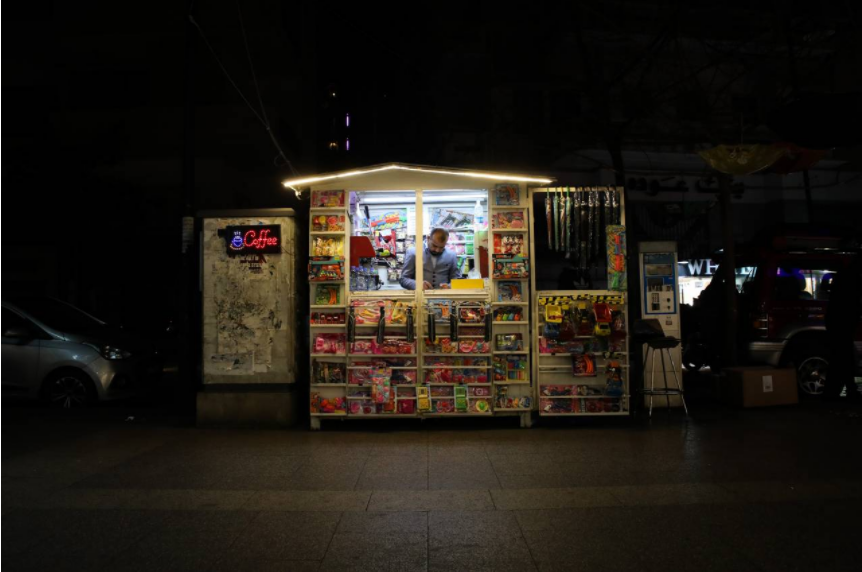 Like war memorials, the kiosks on Hamra Street remind the Lebanese of the street vendors who then shared sidewalks and car hoods. (Credit: Florient ZWEIN/Hans Lucas)
Like war memorials, the kiosks on Hamra Street remind the Lebanese of the street vendors who then shared sidewalks and car hoods. (Credit: Florient ZWEIN/Hans Lucas)
The flight of international brands from the neighborhood
In a country where UN figures from September 2021 suggest 82 percent of the total population lives in “multidimensional poverty,” begging is not unique to Hamra. It’s been argued, however, that the begging was enough to push some clientele away from this commercial artery and toward the shopping centers scattered around Beirut and its outskirts.
This phenomenon is not new. While Hamra was the place to be for local and international brands at the beginning of the millennium, the shopping district did not measure up to these centers that grew rapidly in late 2000s, said Boudisseau, who is a consultant for the real estate consultancy Ramco.
International brands have exited the neighborhood since the start of the crisis, which is no surprise. “Some of these franchises need to return so as to give new life to the neighborhood,” Boudisseau said. This isn’t going to happen in the foreseeable future.
Old businesses that continue to benefit from old tenancy contracts make up “almost half of the neighborhood,” he added. “These merchants open their shops every day, though they have no hope that a single customer will enter.” Landlords, Boudisseau says, justify their eviction of old tenants by arguing they need a new lease and obtain higher rent. If shops stay closed too long, it could give landlords a justification for eviction.
Some merchants have left their shops, however, and a few were replaced by others. Though the new rents are paid in dollars, “they have never been so cheap,” Boudisseau said. “The [rates] in the latest deals were two or even three less. Before the crisis, the [selling] rate per square meter was $1,000 here. Today, it ranges from $300 to $400.”
Money exchanges, which did not exit the neighborhood, are also among the street’s cast of characters. After the local currency lost more than 90 percent of its value, and the banks imposed restrictions on their foreign currency deposits, money exchanges have become a key interlocutor for the Lebanese, juggling the changing dollar-lira exchange rates.
In Hamra, “three new money exchange offices opened in the past six months alone,” Boudisseau said. Although the exchange rate on the parallel market has held steady near LL20,500 per dollar for several weeks, the cost of living did not go down. Besides the infrastructure problems that are happening all over the country, if the exterior appears hostile, a daily internal battle is also ongoing.
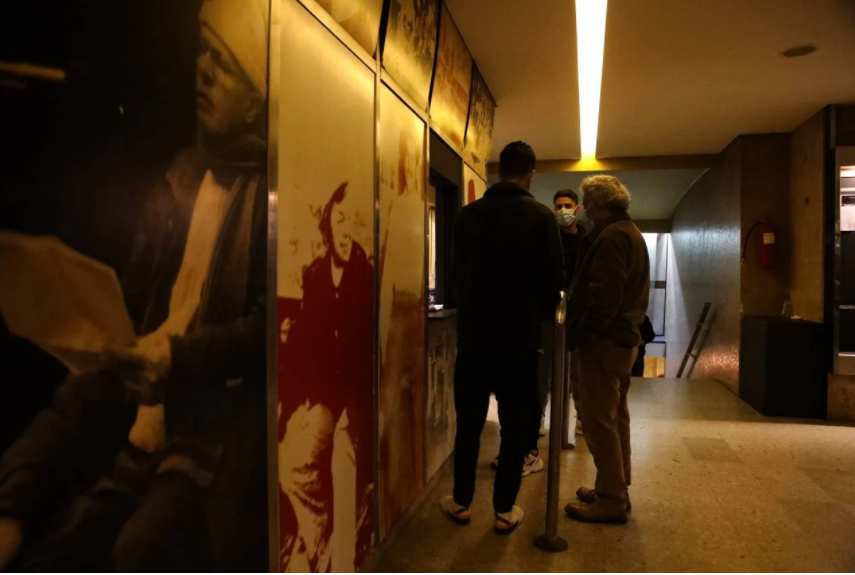 The al-Madina Theater, founded by Nidal Achkar, opened its doors in 2005 and Hamra Street returned to the stage. (Credit: Florient ZWEIN/Hans Lucas)
The al-Madina Theater, founded by Nidal Achkar, opened its doors in 2005 and Hamra Street returned to the stage. (Credit: Florient ZWEIN/Hans Lucas)
The resurrection of al-Madina Theater
“We are surviving,” Abdel Rahman Zahzah said. This is not the first crisis that T-Marbouta is managing. “We were supposed to open in July 2006. The day we were supposed to receive our first espresso machine, straight from a Palestinian camp in southern Lebanon, the Israelis started bombarding the area,” he said.
The restaurant, which was turned into a center welcoming refugees and organizations that came to aid them, became a place of “civil resistance,” he added. Since its inauguration, T-Marbouta has established itself as “a semi-public space at the service of the local community.”
In order to keep going without losing his preferred clients, the restaurant owner chose to “maintain fair prices, reduce [profit] margins and control expenses,” he said. “We must keep this link with the community because it is part of our identity. It is not by chance that we opened in Hamra.”.
Zahzah recalled the sidewalk cafés of the 1960s, “that served as cultural epicenters and public spaces, where discussions were open,” he said. “We are following the same tradition.”
Like T-Marbouta, Al-Madina Theater stands as one of “the vestiges of what the neighborhood was like once,” Boudisseau said. The rental agreement of the theater, which Nidal Achkar had opened in Clemenceau just northeast of Hamra, came to an end in 2004.
“I ignored everyone’s opinion,” she said. While there were still infrastructure problems in the neighborhood, especially electricity and pipelines, “I said, ‘We are going to Hamra’.” A year later, following the renovation works, Al-Madina Theater opened its doors and Hamra took center stage again.
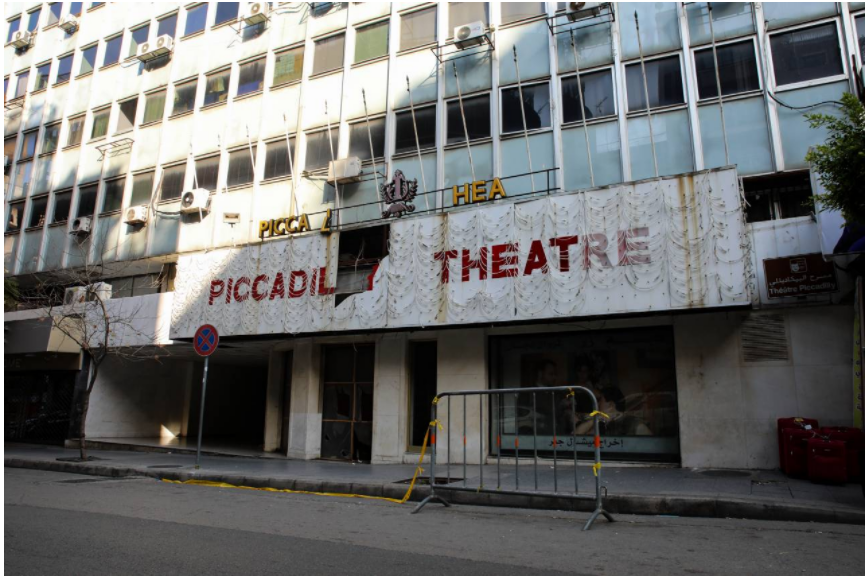 In the ruins of the Piccadilly Theatre, no one sings anymore. Dalida, however, forgot her words there in front of Fairouz in 1973. (Credit: Florient ZWEIN/Hans Lucas)
In the ruins of the Piccadilly Theatre, no one sings anymore. Dalida, however, forgot her words there in front of Fairouz in 1973. (Credit: Florient ZWEIN/Hans Lucas)
‘I am not a heretic’
In this funambulist country, the inauguration of the theater was delayed following the assassination of Rafik Hariri. Forty days later, “I thought that we were alone, along with a few friends, who would be attending the opening,” she recalled. “But the people showed up all of a sudden. It was impressive.”
A fervent admirer of the neighborhood, Achkar has a firm belief that “Hamra is rocking again.”
Then years passed with their many “ups and downs,” and Hamra street’s luster faded in the mirror. As the crisis goes on, the pioneer of Lebanese theater is unsure about the neighborhood’s future. “Hamra carries the memories of our past,” she said, then rejoined, “the future will always be in Hamra.”
In contrast, when commenting on the present, Achkar admits, “Hamra Street is over.” No one is singing anymore in the ruins of the Piccadilly Theater. In the buildings, the offices are deserted and the cinemas no longer exist.
The Horseshoe café has long since shut. “The war wreaked havoc on it,” a once-frequent customer told L'Orient-Le Jour in 2000. Instead, another sidewalk café, Rossa, opened, beneath a mural of the late Lebanese diva Sabah.
It does not have the same spirit, although Barzakh, a newly opened cafe and library upstairs, recalls the old Hamra.
In July 2020, a man shot himself in the head at the entrance to the Saroula cinema building. Attached to his chest, there was a note that read, “I am not a heretic,” along with a copy of his clean judicial record. The crisis won its first round that day.
Though sad, Hamra is still bustling. In the evening, the strollers move forward to the bright neon lights and car headlights. Some chat as they smoke shisha on the sidewalk. Others play backgammon on the terrace of a café. Couples window shop.
Groups of teenagers turn the street into a playground. Restaurant owners and merchants scan passers-by, looking for foreign tourists, beggars too. Then, the neighborhood becomes totally dark. There is no electricity. It's time to go home.
This evening, at the entrance to Hamra Street, all three-colors of the traffic light are, strangely, on. Do they go, stop or wait? The motorists are confused.
This article was originally published in French in L'Orient-Le Jour. Translation by Joelle El Khoury and Sahar Ghoussoub.
